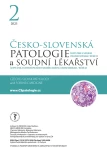Spontaneous abortion in the first trimester of pregnancy
Authors:
Magdaléna Daumová 1,2; Šárka Hadravská 1,2; Martina Putzová 2
Authors‘ workplace:
Šiklův ústav patologie LFP UK a FN Plzeň
1; Bioptická laboratoř s. r. o., Plzeň
2
Published in:
Čes.-slov. Patol., 59, 2023, No. 2, p. 60-63
Category:
Reviews Article
Overview
Spontaneous abortions in the first trimester of gravidity represent a clinically significant problem that can affect up to 15% of recognized pregnancies. The
causes of early pregnancy loss are very heterogeneous and include genetic, environmental and immunological factors. Although the pathologist‘s main task
is to exclude molar pregnancy, in some cases conventional histological examination can also contribute to the elucidation of the cause of miscarriage and the
management of subsequent pregnancies, especially in the case of lesions with a high risk of recurrence that may lead to habitual abortion.
Keywords:
inflammation – trisomy – spontaneous abortion – first trimester – hydropic abortion – abnormal karyotype
Sources
1. The American College of Obstetricians and Gynecologists Practice Bulletin no. 150. Early pregnancy loss. Obstet Gynecol 2015; 125(5): 1258-1267.
2. Redline RW, Zaragoza M, Hassold T. Prevalence of developmental and inflammatory lesions in nonmolar first-trimester spontaneous abortions. Hum Pathol 1999; 30(1): 93- 100.
3. Burgoyne PS, Holland K, Stephens R. Incidence of numerical chromosome anomalies in human pregnancy estimation from induced and spontaneous abortion data. Hum Reprod 1991; 6(4): 555-565.
4. Pinar MH, Gibbins K, He M, Kostadinov S, Silver R. Early Pregnancy Losses: Review of Nomenclature, Histopathology, and Possible Etiologies. Fetal Pediatr Pathol 2018; 37(3): 191-209.
5. Jindal P, Regan L, Fourkala EO, et al. Placental pathology of recurrent spontaneous abortion: the role of histopathological examination of products of conception in routine clinical practice: a mini review. Hum Reprod 2007; 22(2): 313-316.
6. Genest DR, Roberts D, Boyd T, Bieber FR. Fetoplacental histology as a predictor of karyotype: a controlled study of spontaneous first trimester abortions. Hum Pathol 1995; 26(2): 201-209.
7. Kliman HJ, Segel L. The placenta may predict the baby. J Theor Biol 2003; 225(1): 143- 145.
8. Redline RW, Hassold T, Zaragoza MV. Prevalence of the partial molar phenotype in triploidy of maternal and paternal origin. Hum Pathol 1998; 29(5): 505-511.
9. Ornoy A, Salamon-Arnon J, Ben-Zur Z, Kohn G. Placental findings in spontaneous abortions and stillbirths. Teratology 1981; 24(3): 243-252.
10. Redline RW, Hassold T, Zaragoza M. Determinants of villous trophoblastic hyperplasia in spontaneous abortions. Mod Pathol 1998; 11(8): 762-768.
11. Gunnarsdottir J, Stephansson O, Cnattingius S, Akerud H, Wikstrom AK. Risk of placental dysfunction disorders after prior miscarriages: a population-based study. Am J Obstet Gynecol 2014; 211(1): 34 e31-38.
12. Brosens I, Pijnenborg R, Vercruysse L, Romero R. The “Great Obstetrical Syndromes” are associated with disorders of deep placentation. Am J Obstet Gynecol 2011; 204(3): 193- 201.
13. Jauniaux E, Hustin J. Histological examination of first trimester spontaneous abortions: the impact of materno-embryonic interface features. Histopathology 1992; 21(5): 409-414.
14. PrabhuDas M, Bonney E, Caron K, et al. Immune mechanisms at the maternal-fetal interface: perspectives and challenges. Nat Immunol 2015; 16(4): 328-334.
15. Rajcan-Separovic E, Qiao Y, Tyson C, et al. Genomic changes detected by array CGH in human embryos with developmental defects. Mol Hum Reprod 2010; 16(2): 125-134.
16. Shimokawa O, Harada N, Miyake N, et al. Array comparative genomic hybridization analysis in first-trimester spontaneous abortions with ‘normal’ karyotypes. Am J Med Genet A 2006; 140(18): 1931-1935.
17. Megli CJ, Coyne CB. Infections at the maternal- fetal interface: an overview of pathogenesis and defence. Nat Rev Microbiol 2022; 20(2): 67-82.
18. Boyd TK, Redline RW. Chronic histiocytic intervillositis: a placental lesion associated with recurrent reproductive loss. Hum Pathol 2000; 31(11): 1389-1396.
19. Katzman PJ, Genest DR. Maternal floor infarction and massive perivillous fibrin deposition: histological definitions, association with intrauterine fetal growth restriction, and risk of recurrence. Pediatr Dev Pathol 2002; 5(2): 159-164.
20. Faye-Petersen OM, Ernst LM. Maternal Floor Infarction and Massive Perivillous Fibrin Deposition. Surg Pathol Clin 2013; 6(1): 101-114.
21. Mekinian A, Costedoat-Chalumeau N, Masseau A, et al. Chronic histiocytic intervillositis: outcome, associated diseases and treatment in a multicenter prospective study. Autoimmunity 2015; 48(1): 40-45.
22. Khong TY, Bendon RW, Qureshi F, et al. Chronic deciduitis in the placental basal plate: definition and interobserver reliability. Hum Pathol 2000; 31(3): 292-295.
23. Redline RW. Villitis of unknown etiology: noninfectious chronic villitis in the placenta. Hum Pathol 2007; 38(10): 1439-1446.
Labels
Anatomical pathology Forensic medical examiner ToxicologyArticle was published in
Czecho-Slovak Pathology

2023 Issue 2
Most read in this issue
- Spontaneous abortion in the first trimester of pregnancy
- Hydatidiform mole
- Skeletal dysplasias of the fetus and infant: comprehensive review and our experience over a 10-year period
- Molecular diagnosis of complete and partial hydatidiform moles
